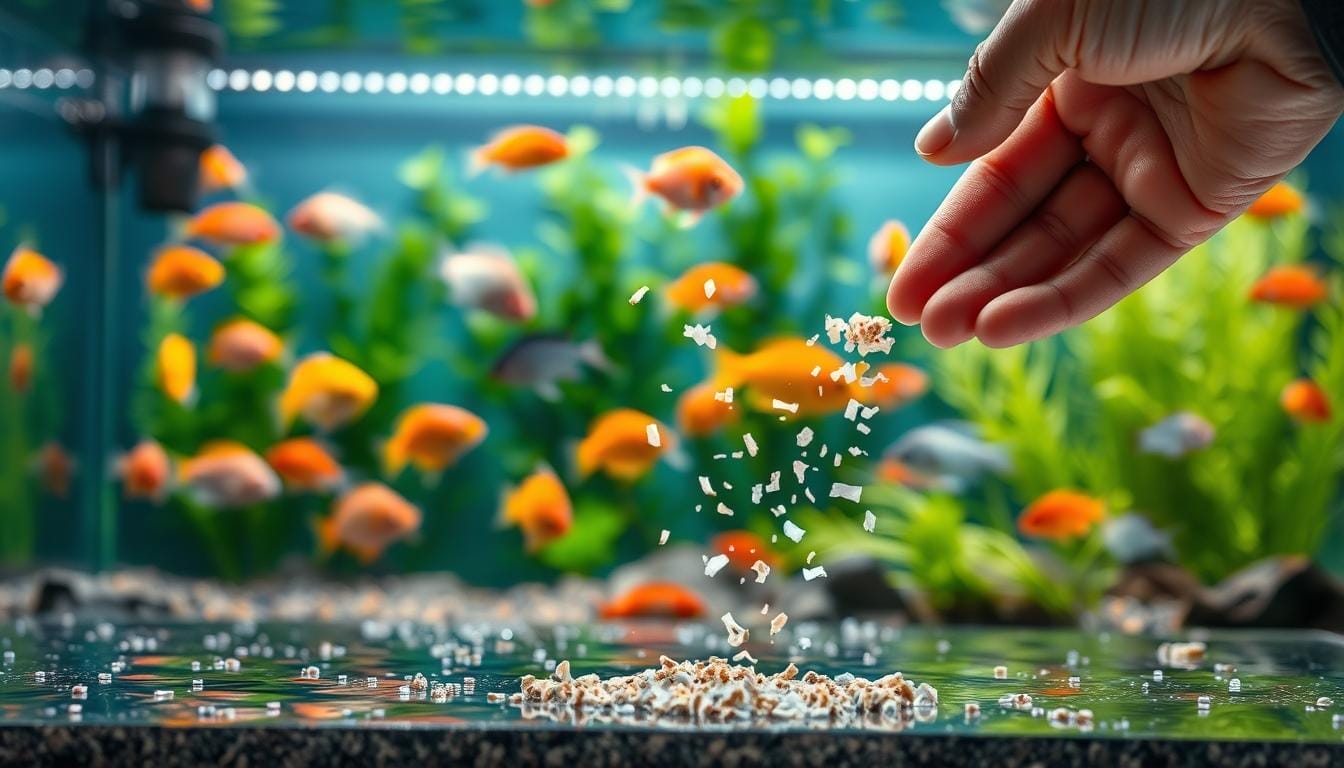
Discover the Best Peaceful Community Fish for Your Aquarium

Did you know 65% of aquarium owners report lower stress levels after adding compatible species to their tanks? A well-planned underwater ecosystem doesn’t just look stunning—it becomes a living meditation space that benefits both you and its inhabitants.
Building a harmonious tank starts with selecting creatures that thrive together. Aggression and competition fade when you pair species with similar temperaments and environmental needs. This approach lets you craft a dynamic underwater scene where every swimmer plays a role in the balance.
You’ll learn how to combine colors, behaviors, and care requirements to create visual harmony. From neon tetras dancing in unison to corydoras cleaning the substrate, each choice impacts your aquarium’s success. We’ll simplify the science behind water chemistry and space requirements so you can focus on the joy of creation.
This guide reveals the secrets to maintaining a stress-free environment where your aquatic companions flourish. Whether you’re starting fresh or upgrading an existing setup, you’ll gain actionable strategies for achieving lasting tranquility in your tank.
Introduction to a Serene Underwater World
The gentle hum of water filtration becomes your personal stress reliever as vibrant swimmers glide through their liquid home. A thoughtfully curated tank transforms into more than decor—it’s a window into nature’s rhythm, where every fin flick and plant sway tells a story.
The Charm of Harmonious Tank Life
Imagine entering a space where neon-bright swimmers dart playfully between plants while bottom dwellers tidy the gravel. This balance isn’t accidental. Selecting species that share temperament and needs lets you create a self-sustaining ecosystem where stress fades like ripples in water.
You’ll notice how compatible tank mates reduce maintenance time. Their interactions become natural water cleaners, while synchronized swimming patterns keep the environment calm. It’s like watching underwater ballet—each movement purposeful, yet effortlessly graceful.
Why a Peaceful Aquarium Matters
Aggression-free tanks aren’t just easier to manage—they become therapeutic hubs. Studies show observing aquatic life lowers heart rates and improves focus. Your aquarium becomes a teacher, revealing how cooperation creates beauty.
By prioritizing harmony, you’re investing in lasting enjoyment. Healthy fish display brighter colors and bolder behaviors, turning your tank into a living mosaic. Plus, you’ll spend less time solving conflicts and more time marveling at your underwater masterpiece.
Key Characteristics of a Great Community Tank Setup
Creating a thriving underwater neighborhood starts with selecting residents who share core traits. These shared qualities help different species coexist while showcasing their natural behaviors. Let’s explore what makes certain swimmers ideal candidates for mixed environments.
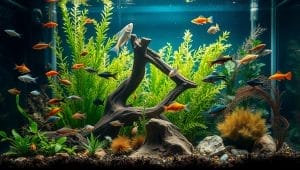
Natural Schooling and Non-Territorial Behavior
Schooling fish instinctively stick together, creating mesmerizing synchronized movements. Species like neon tetras or harlequin rasboras feel secure in groups of six or more, which reduces stress and enhances their vivid colors. You’ll notice they’re less likely to nip fins or chase tankmates when surrounded by their own kind.
Non-territorial swimmers explore every inch of your aquarium without claiming spaces. This trait lets you mix bottom-dwellers with mid-water species seamlessly. Look for active explorers that gracefully share plants and hiding spots rather than guarding them.
Adaptability Across Varied Water Conditions
Versatile species thrive in diverse environments, making them perfect for mixed tanks. Fish that tolerate slight pH or temperature fluctuations let you create harmonious combinations. For example, platies and danios get along well because both adapt to similar water parameters.
Moderate size matters more than you might think. Fish measuring 1.5-3 inches strike the perfect balance—too small becomes prey, too large intimidates others. This middle ground allows different community fish to interact without tension, letting you build a dynamic yet calm underwater world.
Essential Guide: Peaceful Community Fish for Your Aquarium
Building a thriving underwater ecosystem begins with selecting species that click like puzzle pieces. These four proven swimmers form the backbone of balanced tanks, offering visual diversity while maintaining harmony through smart group dynamics.
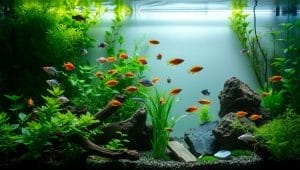
Understanding Compatibility and Group Dynamics
Neon tetras create living fireworks with their electric blue and red stripes. Keep them in groups of six or more to see their true magic—they’ll dart through mid-water zones in synchronized flashes that captivate viewers.
Corydoras catfish act as your tank’s janitorial team. These bottom-dwellers sift substrate while ignoring other swimmers, making them ideal cleanup partners. Their whisker-like barbels constantly search for leftover food, helping maintain water quality.
- Guppies bring nonstop energy with their kaleidoscope tails and rapid movements
- Platies adapt effortlessly to beginner setups, flashing sunset-colored scales
- Combine mid-level tetras with surface-swimming guppies and bottom-cleaning corydoras
These species thrive when their social needs match. Schooling fish feel secure in numbers, while livebearers like guppies prefer open swimming areas. By layering different activity zones, you create a tank where every inhabitant shines without stepping on fins.
Creating the Perfect Habitat for Diverse Species
Your aquarium transforms into a thriving habitat when you match environmental elements to your swimmers’ natural needs. Let’s explore how to craft spaces where every inhabitant feels at home while maintaining visual appeal.
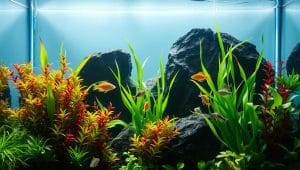
Tank Setup Essentials
Start with sand substrate for bottom-dwellers like corydoras—their delicate barbels stay protected while foraging. A 20-gallon tank or larger gives active species room to explore without collisions. Follow the one-inch-per-gallon rule to prevent overcrowding, but remember: this refers to adult sizes.
Add these elements for success:
- Driftwood arches and smooth rocks create natural barriers
- Java fern or anubias plants offer shaded retreats
- Open swimming lanes in the tank’s middle section
Water Management Made Simple
Multi-species tanks need robust filtration—choose a system rated for 1.5x your aquarium’s volume. Test water weekly for pH swings, especially when mixing compatible species from different regions. Partial 25% changes every 7 days keep nitrate levels safe for all inhabitants.
Remember:
- Match filter flow strength to your swimmers’ preferences
- Use a gravel vacuum during changes to clean sand gently
- Check heater accuracy monthly—sudden temp shifts stress aquatic life
Integrating Colorful and Active Aquarium Inhabitants
Transform your tank into a living canvas by blending swimmers with dazzling hues and dynamic personalities. Strategic selection creates visual depth while keeping interactions stress-free—like curating an art gallery where every piece enhances the others.
Spotlighting Vibrant Species and Their Traits
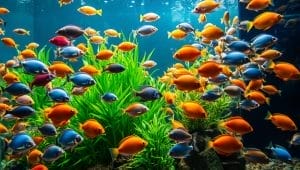
Male cherry barbs steal the show with their bright red bodies that intensify during maturity. Against lush greenery, these 2-inch swimmers create fiery accents that draw the eye without dominating the space. Their calm nature makes them a perfect choice for mixed environments.
Kribensis cichlids offer subtle elegance with rose-tinted undersides. These 3-inch beauties add soft color contrasts while peacefully patrolling lower tank areas. Unlike territorial cichlids, they coexist well with mid-water species when given adequate hiding spots.
Mixing Behavior for a Balanced Display
Platies bring playful energy to your aquatic stage, darting to the surface during feeding like water puppies chasing treats. Their constant motion encourages shy tankmates to explore, creating harmonious activity layers:
- Top zone: Platies and guppies create surface ripples
- Mid-water: Cherry barbs form crimson schools
- Substrate level: Kribensis add gentle movement
This tiered approach lets you enjoy multiple colors and behaviors simultaneously. Active swimmers complement calm ones, ensuring every inhabitant contributes to the tank’s rhythm without competition.
Innovative Aquarium Decor for a Calming Environment
Transform your tank into a living masterpiece where design meets functionality. The right decor choices create visual harmony while supporting your swimmers’ natural instincts. Let’s explore how thoughtful design elements foster tranquility through both beauty and purpose.
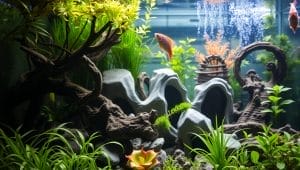
Utilizing Live Plants and Soft Substrate
Live plants turn your aquarium into a breathing ecosystem. Their swaying leaves offer shelter for shy swimmers while absorbing excess nutrients. You’ll notice species get along well when each has defined spaces—broad java fern leaves become resting spots, while tall vallisneria creates vertical barriers.
Soft sand substrate protects delicate barbels on bottom-dwellers and anchors plant roots securely. Pair it with smooth river rocks to mimic natural riverbeds. This combination lets you create aquarium setup ideas that balance open swimming areas with cozy nooks.
Three benefits of planted environments:
- Red-striped rasboras glow against emerald-green backgrounds
- Floating plants diffuse harsh lighting for stress-sensitive species
- Root systems host beneficial bacteria that stabilize water chemistry
Rotate plant varieties seasonally to maintain visual interest. Combine carpeting plants like dwarf hairgrass with mid-height anubias for layered depth. Your aquarium becomes a self-cleaning habitat where decor works with your maintenance routine, not against it.
Expert Tips on Troubleshooting Common Tank Challenges
Even the most harmonious tanks face occasional hiccups—here’s how to keep your aquatic world thriving. Proactive care prevents small issues from becoming major headaches, letting you enjoy your underwater oasis stress-free.
Spotting and Stopping Aggression
You’ll spot early signs of tension when fish get territorial or hide constantly. Rearrange decor weekly to disrupt claimed spaces. This simple reset helps tankmates re-establish boundaries peacefully.
Introduce new fish after lights-out to reduce confrontation. Quarantine newcomers for two weeks first—this prevents disease spread and lets aggressive personalities show before joining the main tank.
Balancing Population and Purity
Overcrowding sneaks up fast. Follow the one-inch-per-gallon rule, but subtract decor space. If fish get stressed during feeding, consider rehoming some or upgrading your setup.
Cloudy water often means excess waste. Test ammonia weekly and get rid of debris with a gravel vacuum. Increase filter maintenance when adding new fish, as bioloads shift.
These strategies help your aquatic family get along while keeping environments pristine. Remember—observant care creates lasting harmony where every swimmer thrives.
FAQ
How do I choose tankmates that coexist well in a shared environment?
Focus on species with similar needs, like neon tetras and platies, which thrive in groups of 6+ and prefer neutral pH. Avoid mixing fin-nippers with slow swimmers—corydoras catfish pair well with most small tropical species due to their calm bottom-dwelling habits.
What water parameters work best for mixed-species setups?
Aim for 72–78°F and pH 6.5–7.5 to accommodate popular choices like harlequin rasboras and cherry barbs. Use a reliable test kit like the API Freshwater Master Kit to monitor ammonia and nitrite levels weekly, especially when introducing new additions.
Can I use sand substrate with all community species?
Yes! Fine sand is ideal for corydoras and kuhli loaches, protecting their delicate barbels. Pair it with smooth rocks and driftwood. For plant-friendly setups, try CaribSea Eco-Complete planted substrate, which supports both flora and fauna.
How do I prevent overcrowding in a 20-gallon tank?
Follow the “one inch per gallon” rule, but account for adult sizes. Example: 10 neon tetras (1.5” each) + 6 pygmy corydoras + 1 honey gourami fits comfortably. Use Aqueon QuietFlow filters to maintain water clarity without strong currents.
What’s the best way to handle unexpected aggression?
Rearrange decor to disrupt established territories and add more hiding spots using Java fern or ceramic caves. If issues persist, rehome aggressive fish like serpae tetras and replace them with docile alternatives like celestial pearl danios.
How often should I test water quality in a planted tank?
Test weekly for the first 8 weeks, then biweekly once stable. Focus on nitrate levels (keep below 20 ppm) using Seachem MultiTest strips. Live plants like anubias and hornwort help absorb excess nutrients naturally.
Can I keep shrimp with small tropical species?
Yes! Cherry shrimp and amano shrimp coexist safely with ember tetras or otocinclus. Avoid larger fish like angelfish that may view shrimp as food. Provide mosses and cholla wood for shrimp hiding spots.
How do I manage fry without a separate breeding tank?
Use dense plants like Java moss as natural nurseries. Species like endlers livebearers produce fewer fry than guppies, making population control easier. For egg-scatterers like danios, add a mesh breeding grid.





